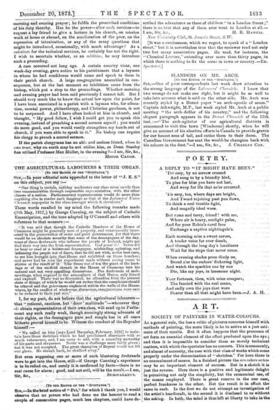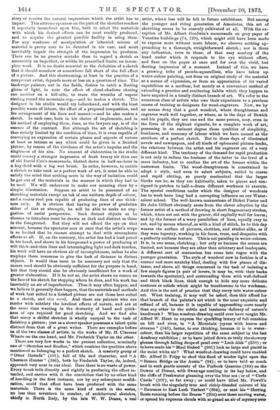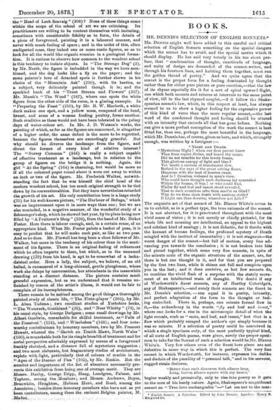ART.
SOCIETY OF PAINTERS IN WATER-COLOURS.
As a general rule, the less a critic of pictures concerns himself with methods of painting, the more likely is he to arrive at a just esti- mate of their results. But it often happens that the processes of art form an essential element of the effect produced upon the eye; and then it is impossible to consider them as merely technical matters, with which the spectator has no concern. This iscommonly, and almost of necessity, the case with that class of works which come properly under the denomination of "sketches." For here there is no concealment of means. In a finished picture the ars celare artem may be an important element of success. Bat in a sketch it is just the reverse. Here there is a positive and legitimate delight in perceiving not only the simplicity, but the economical use, of the means employed. There is great reserve in the one case, perfect frankness in the other. But the result is in effect the same in each. In the first we do not attempt an investigation of the artist's handicraft, in the second it is disclosed to us without the asking. In bothr the mind is thus left at liberty to take in the
story or receive the natural impressions which the artist has to impart. This extreme openness on the part of the sketcher renders it especially incumbent upon him, both to select the materials with which his desired effects can be most readily produced, and to acquire the greatest possible facility in using them. For any weakness of manipulation or laboured misuse of material is pretty sure to be detected in his case, and must inevitably impair the strength of the impression he produces. There can be no greater mistake than to regard a sketch as necessarily an imperfect, or within its prescribed limits, an incom- plete work. It is no doubt essential to the definition of a sketch that it should somehow or somewhere fall short of the full effect of a picture. And this shortcoming, at least in the practice of a competent artist, depends more or less on a question of time. The landscape painter, out in the fields, desires to catch a fleeting gleam of light, to note the effect of cloud-shadows chasing one another on a hill-side, to trace the wreaths of vapour circling round the mountain-top,—and he makes a sketch. The designer in his studio would try beforehand, and with the least possible waste of labour, the effect of a proposed composition, and the arrangement of his lines and masses ;—and he also makes a sketch. In each case, both in his choice of implements, and in his method of employing them, time, as the lawyers say, is of the essence of the contract. But although the art of sketching is thus strictly limited by the condition of time, it is even capable of conveying an expression of certain phases and aspects of nature at least as intense as any which could be given in a finished picture, by reason of the vividness of the artist's impulse and the singleness of his aim. No amount of elaboration in the studio could convey a stronger impression of fresh breezy air than one of old David Cox's memoranda, blotted down in half-an-hour in a hay-field with a big wet brush. In order, however, to entitle a sketch to take rank as a perfect work of art, it must be able to satisfy the mind that nothing more in the way of imitation could be got out of the materials in the manner in which they had to be used. 1Ve will endeavour to make our meaning clear by a simple illustration. Suppose an artist to be possessed of no sketching materials except an ink of one uniform depth of colour, and a coarse reed pen capable of producing lines of one thick- ness only. It is obvious that having no power of gradation either of tint or strength, he will be able to make no sug-
gestion of aerial perspective. Such distant objects as he chooses to introduce must be drawn as dark and distinct as those in the foreground. But they will not offend the eye on that account, because the spectator sees at once that the artist's scope is so limited that he cannot attempt to deal with atmospheric effects at all. If, on the contrary, the artist has had a lead pencil in his hand, and shows in his foreground a power of producing at will thick-and-thin lines and intermingling light and dark touches, his work will have an obvious air of incompleteness, unless he also employs these resources to give the look of distance to distant objects. It would thus seem to be necessary not only that the means used should be obviously sufficient for the purpose in hand, but that they should also be obviously insufficient for a work of greater elaboration. If it be not so, the artist shows no reason on the face of his sketch for stopping where he does, and his work has inevitably an air of imperfection. Thus it may often happen, and we believe it generally does happen, that the materials and methods of work best suited to a finished picture are not those best suited to a sketch, and vice versa. And there are painters who can render with subtlety the loveliest effects of nature, and are at the same time wanting in the dexterity of hand and quick- ness of eye required for good sketching. And we find also that many a skilful sketcher is wholly unequal to the task of finishing a picture; just as a clever speaker possesses a talent quite distinct from that of a great writer. There are examples before us of the two classes of artists, in the works of Mr. H. Clarence Whaite on the one hand, and Mr. Frederick Tayler on the other.
There are very few works in the present collection, nominally one of " Sketches and Studies," which combine the qualities above mentioned as belonging to a perfect sketch. A masterly group of "Otter Hounds" (101), full of life and character, and "A Chestnut Hunter" (186), both by Frederick Tayler, do, indeed, approach very near to our ideal. Here there is no waste of power. Every touch tells directly and rightly in producing the effect in- tended, and carries with it the conviction that by no other kind of handling in the first instance, nor by any subsequent modifi- cation, could that effect have been produced with the same materials. There is the same kind of merit in the series, no less than seventeen in number, of architectural sketches, chiefly in North Italy, by the late W. W. Deane, a real artist, whose loss will be felt in future exhibitions. But among the younger and rising generation of Associates, this art of sketching seems to be scarcely cultivated at all. With the ex- ception of Mr. Albert Goodwin's memoranda on grey paper of Venetian buildings (74, 129), which might still have been made to express more without more labour, we observe nothing ap- proaching to a thorough, straightforward sketch ; nor is there any indication, even in these, of that easy mastery of the under which it responds to the eye without effort, and fixes on the paper at once and for ever the vivid, but fleeting impression of a moment. Instead of this, we have a growing tribe of pseudo-aquarellists, who have taken up water-colour painting, not from an original study of the material as a means of expression, or from an appreciation of its varied capabilities as a medium, but merely as a convenient method of extending a practice and continuing habits which they happen to- have acquired in a totally distinct branch of art. We refer to the numerous class of artists who owe their experience to a previous- course of training as designers for wood-engravers. Now, we by no means deny that a good woodcut, where draughtsman and engraver work well together, or where, as in the days of Bewick and his pupils, they are one and the same person, may, even in the form of the slightest vignette, be a complete work of art, possessing in an eminent degree those qualities of simplicity, frankness, and economy of labour -which we have named as the attribute of a perfect sketch. But in these days of illustrated novels and newspapers, and all kinds of ephemeral picture-books, the relations between the artist. and his engraver are of a very different kind. The tendency of the demand for rapid production is not only to reduce the business of the latter to the level of a mere industry, but to confine the art of the former within the narrowest limits. The wood-draughtsman is constrained to adopt a style, and even to select subjects, suited to coarse and rapid cutting, so purely mechanical that the larger blocks can be, as they are habitually, taken to pieces and con- signed in patches to half-a-dozen different workmen to execute.. The special conditions under which the designer of woodcuts has to work have long had a corrupting influence on our Water- colour school. The well-known mannerisms of Birket Foster and Sir John Gilbert obviously arose from the clever adoption by the former artist of a method of drawing in short fragmentary strokes, which, when cut out with the graver, did capitally well for leaves; and by the former of a wavy parallelism of lines, equally easy to cut, and by means whereof, as with a kind of stitch, he to this day weaves the surface of pictures, sketches, and studies alike, as if they were tapestry, working in his faces, trees, and draperies with a perfectly uniform texture. This is not painting in water-colours. It is, in one sense, sketching ; but only so because the means are limited, not because they are other than arbitrary and inadeq uate- A different sort of mannerism has come into vogue with the younger generation. The style of woodcut now in fashion is of a coarser and more scratchy kind, dealing with few planes of dis- tance, and above all things concerned in the task of isolating a few simple figures (a pair of lovers, it may be, with their backs towards the spectator), and surrounding them with well-defined and thick black lines, thick enough to hide any more delicate- contours or reliefs which might be troublesome to the workman Andthis is the sort of practice that they carry into water-colour art. What training, it may well be asked, does this afford for that branch of the painter's art which is the most exquisite and refined of all, because it is capable of approaching more nearly than any other to the subtle and luminous delicacy of nature's handiwork ? What woodcut-drawing could ever have taught Mr. Alfred W. Hunt to express the sparkling luxury of full sunshine on hill and river, in "A Mountain joyous with leaves and streams" (343), better, to our thinking, because it is in water- colour, than his larger repetition of the same subject in the last Academy exhibition ; or to have jotted down so truly the showery gleams through falling drops of pearl over "Loch Alsh " (330) ; or to have made his "Moel Siabod " (381) look so large and placid in the moist white air ? What woodcut-drawing could have enabled Mr. Alfred D. Fripp to shed this flood of tender light upon the Bridge on the Aunio" (94); or to have told so much- and in such gentle accents of the Purbeck Quarries (184) on the Downs of Dorset, with Swan age nestling in its bay below, and the cliffs of Freshwater gleaming over the blue sea ; or of " Corfe Castle" (207), so far away ; or could have filled Mr. Powell's brush with the singularly true and richly-blended colours of his "Entrance to East Loch Tarbert "(384), or sent his "Herring Boats running before the Breeze" (304) over those moving waves, or spread his vaporous clouds with so grand an air of mystery over the "Head of Loch Scavaig " (206) ? None of these things come Within the scope of the school of art we are criticising. Its practitioners are willing to be content themselves with imitating, sometimes with considerable fidelity as to form, the details of a piece of foreground, painting it in a laboured manner, and never with much feeling of space ;. and in the midst of this, often undigested mass, they imbed one or more rustic figures, so as to look for all the world like-organic remains in a geological forma- tion. It is curious to observe how common to the woodcut school is this tendency to isolate objects. In "The Strange Dog" (3), by Mx. North, the figure is imbedded in the way we have men- tioned, and the dog looks like a fly on the paper ; and the same painter's love of detached spots is further shown in his -choice of the " Mountain Ash" (230), with its berries, as V. subject, very delicately painted though it is; and the speckled bank of his "Trout Stream and Flowers" (237). Mr. Marsh's "The Wood" (187), where one spots the white figure from the other side of the room, is a glaring example. In 4 6 Preparing the Feast" (210), by Mr. R. W. Macbeth, a white duck makes one spot, and a yellow mass, composed of the head, breast, and arms of a woman feeding poultry, forms another. Such crudities as these would not have been tolerated in the palmy days of water-colour art. In Mr. J. D. Watson's works, the painting of which, as far as the figures are concerned, is altogether of a higher order, the same defect is the more to be regretted, because the figures themselves are exceedingly graceful. But why should he divorce the landscape from the figure, and divest the former of every kind of relative interest? The Surrey Common" (246) is really a subject capable of effective treatment as a landscape, but in relation to the group of figures on the bridge it is nothing. Again, the girl "At the Spring" (161) is charming, but would be more so if all the coloured paper round about it were cut away to within an inch or two of the figure. Mr. Frederick Walker, notwith- standing the fact that he was himself the chief head of the modern woodcut school, has too much original strength to be tied down by its conventionalities. But they have nevertheless retarded the growth of his art. His only contribution here is a large study (33) for his well-known picture, "The Harbour of Refuge," which was an improvement upon it in more ways than one ; but we are also reminded, in a negative manner, of the wonderful study of a fishmonger's shop, which he showed last year, by its place being now filled by "A Fruiterer's Shop" (326), from the handof Mr. Birket Foster. Here there is labour enough, and, in a certain sense, of an appropriate kind. When Mr. Foster paints a basket of peas, it is easy to predict that he will make each pair, as like as two peas. And so he does. Mr. Rinwell has long been a close follower of Mr. Walker, but more in the tendency of his colour than in the senti- ment of his figures. There is an original feeling of refinement which he often imparts to them, but which, as in the unnamed drawing (179) from his hand, is apt to be somewhat of a lacka- daisical order. Here a lady, the subject, we believe, of an old ballad, is enamoured of a long-chinned, gentle ploughman, whose work she delays by conversation, her attendants in the meanwhile standing at a discreet distance. The picture contains much graceful expression, but as we understand that it remains un- finiehed by reason of the artist's illness, it would not be fair to -complain of its incompleteness..
There There remain to be noticed among the good things a thoroughly painted study of classic life, " The.Flute-player " (366), by Mr. L. Alma Tadema ; two excellent studies of Yorkshire becks, 4' The Waterark, G01441=4;1" (OP)? and "Near Whitby" (78), in his usual style, by George. Dodgson ; some small drawings-by Mr. Albert Goodwin, remarkable for skilful treatment, as" Falls of the Frassioei " (131), and Wincheisea " (168); and four note- worthy contributio,na by honerary members, two by Mr. Prescott Hewett, whereof the "Sketch on Traeth Mawr, North Wales" (100),is reroarkahleboth for its simple breadth of treatment and for aerial perspective admirably expressed by means of a foreground frankly sketched, and .a ,distance full, of mysterious suggestion ; awl two most elaborate, but fragmentary studies of architecture, replete with light, particularly that of colours of marble in the -" Apse of the Duomo ef Plea" (104), by Mr. Ruskin. But the -0 timber and bppertanee of the list a absentees necessarily pre- vents this exhibition from being one of average merit. They are Messrs., Danby, George Fripp, Haag, Lundgren, Palmer, and Tophani, among the Members ; and Messrs. Andrews, Boyce, Branwbite, Houghton, Holman Hunt, and Read, among the Associates ; besides three honorary-members who have not as yet been contributors, among them the eminent Belgian painter, M. Madou.












































 Previous page
Previous page